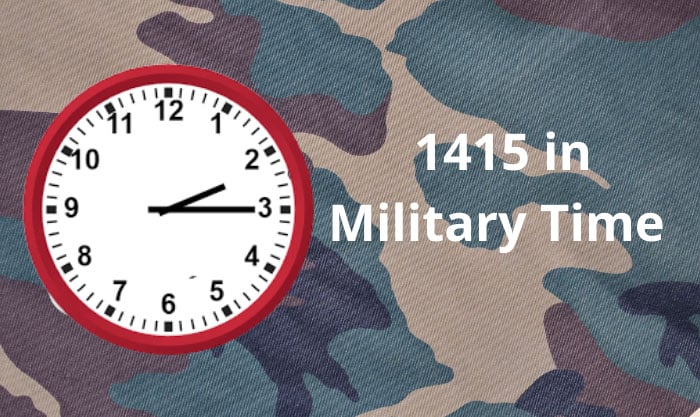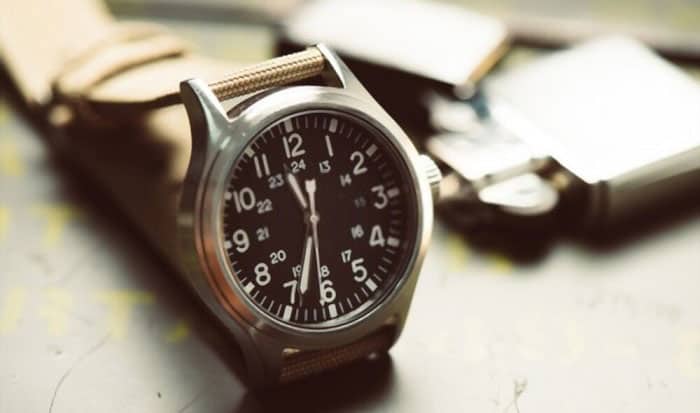Imagine: You’re playing the game “What’s time is it, Mr. Fox?” but Mr. Fox is a veteran and calls out it’s 1415 in military time! Now what? What is 1415 in military time? Don’t worry, we have the answer right here for you.
1415 in military time is 2:15 P.M in 12-hour time format and 14:15 in 24-hour time format. But in order to win this game with Mr. Fox, you will need to be able to convert any other time on your own. To do that, read the rest of this short but detailed article.
We will explain what military time is, how it is different from standard time, and how to convert it to standard time and vice versa. So, “clock in” to find everything you need to know.
In detail, we are covering:
Table of Contents
- What Is Military Time? How Does It Differ From Standard Time 12-hour and 24-hour Format?
- How Can We Read Military Time? What Are the Rules to Abide by?
- How Can We Convert Military Time Into Standard Time (12-hour Format)?
- What Is 14:15 in Military Time?
- How Can We Convert Standard Time (12-hour Format) Into Military Time?
- Conclusion
What Is Military Time? How Does It Differ From Standard Time 12-hour and 24-hour Format?
Military time is time used by the military (Duh!). It is a lot more different from the 12-hour time than the 24-hour time. The latter uses P.M and A.M notations, which are abbreviations for post meridiem and ante meridiem, respectively.
Both the 12-hour and 24-hour time format also uses a colon (:), which separates the hours and the minutes, while military time does not. The four digits in military time stand side by side. Like the 24-hour time format, however, the first two digits are the “hours” and the remaining two are the “minutes”.
Moreover, military time is already different from 12-hour time and 24-hour time. You will hear “zero”, “oh”, “hundred”, and “hours” rather than “P.M”, “A.M”, and “o’clock”. We will explain this in more detail later.
Read on this post to find know the reasons why the military use 24-hour instead of 12-hour!
How Can We Read Military Time? What Are the Rules to Abide by?
Reading military time is not as difficult as it sounds. By the time you finish this article, you will be able to read military time in your sleep! Here are the rules:
To read the hours alone/without the minutes:
- Read the time given + the word “hundred” or the words “hundred hours”.
- With hours before 9, read “zero” then the hour given.
- In less professional or diplomatic situations, switch “zero” to “oh”.
- With hours after 9, omit the “zero” or “oh” and read the hours as pairs.
Applying these rules,
- 0200 is read as “zero two hundred” or “zero two hundred hours”.
- Or in less formal situations, “oh two hundred” or “oh two hundred hours”.
- 1200 is read as “twelve hundred” or “twelve hundred hours”.
To read the hours with minutes, omit the word “hundred”.
Now, let’s move on to learning how to read the minutes:
Apply the same rules.
- Minutes before 9 – Read as “zero” or “oh” > the minute given.
- Minutes after 9 – Read without “zero” or “oh”, just the minutes as pairs.
For example, if it is 1225 military time, you read it as “twelve twenty-five”.
You can watch more from this video on Youtube.
How Can We Convert Military Time Into Standard Time (12-hour Format)?
There are two key rules that you must keep in mind:
- If the hour is above 1200, subtract the hour with 1200 and add a “P.M”.
- If the hour is below 1200,
- the “hours” are the first two digits and are accompanied by “A.M”
- the “minutes” are the last two digits
Here are the conversion steps to take:
- Step 1: Separate the four digits into the hours and the minutes.
- Step 2: Determine if the given time is greater than 1200 and apply the rule above.
- Step 3: Keep the minutes the same.
- Step 4: Put a colon in between the hours and the minutes.
- Step 5: Add an “A.M” or a “P.M” depending on whether the time is greater than 1200.
What Is 14:15 in Military Time?
Why don’t we work through these steps for our central query on 1415 military time?
- Step 1: Separate 1415. We get 14 15; 14 hours and 15 minutes.
- Step 2: Is 1415 greater than 1200? Yes. So, applying the rule above, we take 12 hours away from 14. 14 – 12, we get 2; 2 hours.
- Step 3: 15 minutes stay 15 minutes.
- Step 4: Put a colon in between the hours and the minutes, we get 2:15.
- Step 5: Finally, we complete with a P.M since 1415 is greater than 1200.
Our converted standard time is 2:15 P.M! (Don’t mistake this with 2:15 in military time or 14:15 military time!)
How Can We Convert Standard Time (12-hour Format) Into Military Time?
You can convert from standard time into military time as well; just work backward! For example, using the same case:
- Step 1: Notice the P.M in 2:15 P.M and understand that in military time, the value is > than 12:00. As such, add 12 hours to 2 rather than subtract. Get 14 hours.
- Step 2: Keep the minutes as they are. So, we still have 15.
- Step 3: Take out the P.M and the colon (They don’t appear in military time)
- Step 4: Get the converted time. We are left with 1415.
Here’s a chart that you can refer to when you do not have the time to manually convert:
| Standard | Military |
| 0000 | 12:00 Midnight |
| 0100 | 1:00 A.M |
| 0200 | 2:00 A.M |
| 0300 | 3:00 A.M |
| 0400 | 4:00 A.M |
| 0500 | 5:00 A.M |
| 0600 | 6:00 A.M |
| 0700 | 8:00 A.M |
| 0900 | 9:00 A.M |
| 1000 | 10:00 A.M |
| 1100 | 11:00 A.M |
| 1200 | 12:00 P.M |
| 1300 | 1:00 P.M |
| 1400 | 2:00 P.M |
| 1500 | 3:00 P.M |
| 1600 | 4:00 P.M |
| 1700 | 5:00 P.M |
| 1800 | 6:00 P.M |
| 1900 | 7:00 P.M |
| 2000 | 8:00 P.M |
| 2100 | 9:00 P.M |
| 2200 | 10:00 P.M |
| 2300 | 11:00 P.M |
| 2400 | 12:00 P.M |
If you are wondering what time is 14:15 pm, understand that you’re starting from standard time but in 24-hour format. Hence, convert it into the 12-hour format first, then use the steps you’ve learned above. To do this, use the first rule we went over, or this online calculator.
Conclusion
Now, you won’t halt in confusion if Mr. Fox says 1415 in military time. You may even boast back that it should be “fourteen fifteen hours”! Indeed, “what is 1415 in military time?” is only one of the many questions you answered using this article.
Did you find this helpful and easy to follow? Leave your thoughts in the comments! Don’t forget to bookmark this for future reference and share this content with other readers as well.

I am Everett Bledsoe, taking on the responsibility of content producer for The Soldiers Project. My purpose in this project is to give honest reviews on the gear utilized and tested over time. Of course, you cannot go wrong when checking out our package of information and guide, too, as they come from reliable sources and years of experience.



